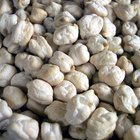Most vegetables freeze well when you prepare and package them carefully, and pole beans are no exception. Freezing does not stop the deterioration of foods completely. Handling the fresh beans properly, wrapping them well, maintaining the recommended freezer conditions and using the beans within the advised time frame will help you preserve the nutritional and textural qualities of the vibrant, crisp pods.
Trim the Beans
Discard soft or damaged bean pods, or trim off damaged portions with a paring knife. Pole beans should be fresh, firm and crisp. Remove and discard stems on any pods. Rinse the pods in cold water. Cut them into smaller pieces -- about 2 to 4 inches long -- if desired.
Blanch the Beans
Blanching pole beans before freezing them eliminates dirt or bacteria that may be present on the surfaces of the pods and slows enzymatic processes that will cause the beans to deteriorate over time. Blanching also helps preserve the texture of the beans and make their colors more vibrant. Blanch the beans in batches if you have a lot.
Fill a stockpot with salted water.
Use 1 gallon of water for every 1 pound of pole beans you are freezing. Bring the water to a boil. Add a liberal volume of salt to the water, which enhances the flavor of the beans. Using a 3-percent saltwater solution -- about 7 1/2 tablespoons of salt for every gallon of water in the pot -- enhances their flavor, according to Daniel Gritzer, culinary director of serious eats.
Put the beans in a blanching basket.
Place the pods in batches in a blanching basket -- also called a steamer basket -- a utensil that makes it easier to submerge the veggies. Remove each batch of beans quickly and continue blanching batches as needed. You can blanch the beans without a basket, but it may be more time consuming to transfer loose pods and bring successive pots of water to a boil.
Blanch the beans.
Submerge the basket of beans or loose pods in the boiling water. Cover the stockpot with a lid. Watch for the water to resume boiling, which will take approximately 1 minute. Start timing the process once the water begins boiling again. Blanch the pole beans for 3 minutes. Remove them from the heat as soon as you reach the 3-minute mark.
Cool the beans.
Quick-cool or "shock" the pods as soon as you remove them from the heat. Shocking blanched vegetables stops the cooking process. Allowing pole beans to sit in boiling water as it cools even for 1 to 2 minutes can result in partially cooked, dull-colored beans that are soggy when you thaw them. Pods chilled quickly will retain crispness and vibrancy.
Dump the contents of a blanching basket into a large bowl of ice water. An ice-water bath is the most effective quick-cooling method. Pour loose pods and their boiling water into a large colander to drain the beans before you shock them in a bowl of ice water.
Quick-cool blanched beans in a colander under cold, running water if you don't have any ice. Shake the colander continuously to gently toss the pods, which will help you expose all of them to the cool water. Keep blanched pole beans submerged under running water or ice water until they are cool to the touch.
Air-Dry the pods.
Drain the pole beans. Spread them on a baking sheet lined with paper towels or clean dish towels so that any water remaining on the surface of the pods can evaporate. Packaging wet vegetables causes frost to develop, which leaves the beans soggy, soft and limp. The surfaces of the pods should air-dry in about one hour.
Freezing and Storing
Packaging pole beans effectively for freezer storage is critical to protecting their textural and nutritional integrity. Pods that are not protected from freezer air can develop freezer burn, which degrades the texture, appearance and flavor of the beans. Exposure to freezer air can also cause the beans to develop an off taste, and it leaves them susceptible to contamination. Package pole beans in airtight, moisture-vapor resistant food-storage materials designed for freezing. Rigid plastic containers with tight-fitting lids work well. Zipper-seal plastic freezer bags also work. Bags may be easier to accommodate in your freezer because you can lay them flat.
Pack the Pods
Pack dry pole beans into one or more rigid food-storage containers.
- Leave 1/2-inch of head space between the top of the beans and the rim of the container.
- Seal the container with a tight-fitting lid.
Or scoop dry pole beans into one or more freezer bags.
- Fill the bag to about half its capacity if you want to lay it flat and stack multiple bags.
- Press as much air out of the bags as possible as you seal them.
Freezer Conditions
Affix a label or piece of freezer tape to each container or bag. Note the contents and date frozen on the label with a smudge-proof pen or marker.
Keep It Cold
Keep your freezer temperature at or below zero degrees Fahrenheit. Blanch and freeze portions of pole beans in 24-hour increments if you have more than 3 pounds to freeze. Putting too many room-temperature containers in the freezer at the same time raises the temperature of the freezer, which leaves already frozen foods at risk for partial thawing or contamination. It also takes longer to adequately freeze all of the new foods in the freezer.
Arrange Frozen Foods Thoughtfully
Leave some space around the containers or bags of pole beans for the first 24 hours that they are in the freezer so that air can circulate around them. This will increase the likelihood that they freeze quickly and thoroughly. You can stack or arrange the containers closely once the pods have frozen through to free up space in your freezer. Keep the containers that have been in the freezer the longest closer to the front so that you use them first.
Cooking the Beans
Use frozen pole beans within 12 months for the best texture and flavor. Cook frozen pole beans immediately after you remove them from the freezer: Do not thaw them. Add frozen pods directly to any recipe that calls for boiled, oven-roasted or sautéed pole beans. Boil the pods until they are tender before you add them to casseroles.
Related Articles

How to Freeze Garbanzo Beans

How to Blanch Green & Yellow Beans

How to Blanch Green Beans for Freezing

How to Freeze Romanesco
How to Freeze Fresh Shelled Black Eyed ...

How to Freeze Edamame Soybeans

How to Reconstitute Dried Beans

How to Preserve Rutabagas

How to Soak Adzuki Beans

How to Freeze Shelled Edamame

What if You Don't Cook Chickpeas Long ...
How to Preserve Kohlrabi

How to Dehydrate Peas

Should You Steam or Blanch Bean Sprouts ...

How to Blanch, Peel, & Freeze Whole ...

How to Freeze Cooked Dried Beans

How to Blanch Lima Beans

How to Cook Dragon's Tongue Beans

How to Preserve Pimentos

How to Cook Romano Beans
Writer Bio
Lamar Grey has been writing about cooking and food culture since 2010. He has ghostwritten eight cookbooks. Grey entered the culinary industry in 2003 as a prep cook in a full-service restaurant. He subsequently served as a baker and head cook on three award-winning kitchen staffs.